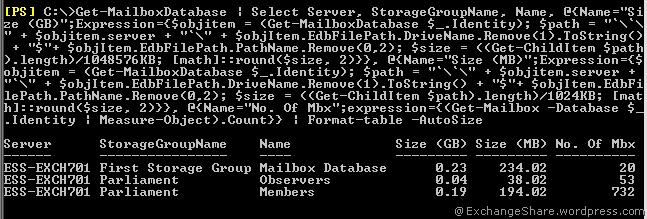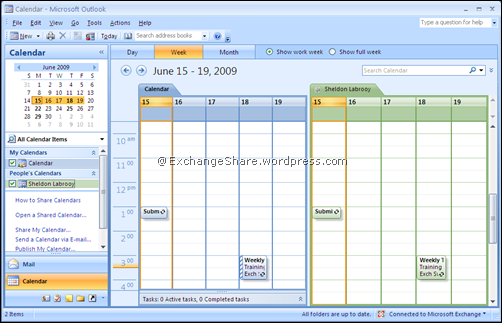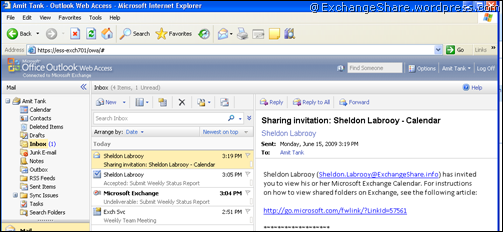Archive for the ‘Tools’ Category
Guided walkthroughs for Exchange and Office 365
Here are some of the helpful guided walkthroughs for Microsoft Exchange Server, Office 365 and for Lync Server, SharePoint Server too…
Exchange Server
| Outlook Connectivity Guided Walkthrough – Troubleshooter | http://aka.ms/outlookgwt | ||
| Troubleshoot ActiveSync with Exchange Server | http://aka.ms/easgwt | ||
| Exchange Server 2010 Datacenter Switchover | http://aka.ms/2010DatacenterSwitchovergwt | ||
| Troubleshoot Public Folder Replication for Exchange Server 2003 | http://aka.ms/2003pfgwt |
Exchange Online / Office 365
| Mail Flow Guided Walkthrough for Office 365 – Troubleshooter | http://aka.ms/FixEmail | |
| Office 365 Outlook Connectivity Guided Walkthrough – Troubleshooter | http://aka.ms/outlookconnectivity | |
| Setting up a mailbox that multiple users can access and use | http://aka.ms/sharedgwt | |
| Sending email from another person’s mailbox or from a group in Office 365 Guided Walkthrough | http://aka.ms/sendasgwt | |
| Accessing other people’s mailboxes in Office 365 Guided Walkthrough | http://aka.ms/mailboxaccessgwt | |
| Creating and managing resource mailboxes (conference rooms/equipment) in Office 365 | http://aka.ms/resourcegwt | |
| Sharing calendar and contacts in Office 365 Guided Walkthrough | http://aka.ms/sharedfoldersgwt | |
| Hybrid Migration Troubleshooter | http://aka.ms/hybridmigrationgwt | |
| Hybrid Environment Free/busy Troubleshooter | http://aka.ms/o365freebusygwt |
Lync Online
| Set up Lync Online external communications | http://aka.ms/lyncgwt1 | |
| Troubleshooting Lync Online sign-in for admins | http://aka.ms/LyncSignIn | |
| Troubleshooting Lync Online sign-in for users | http://aka.ms/lyncsigninusers |
SharePoint Online
| OneDrive for Business – Initial Sync Setup Guide | http://aka.ms/odbsyncsetup | |
| OneDrive for Business Sync App (formerly SkyDrive Pro) – Sync Issues Guide | http://aka.ms/odbsyncissues |
U-BTech: Exchange 2010 ROI Tool
I just came across a handy tool to calculate Return Of Investment (ROI) on Exchange deployment. Tool is developed by U-B Tech and available at free of cost to use.
Use U-BTech’s Exchange 2010 ROI tool to compare the costs of implementing Exchange 2003, 2007 and 2010 and try different cost variations including storage costs, hardware costs, licensing costs and more by just providing basic inputs.
Download: U-BTech’s Exchange 2010 ROI Tool
Here are screenshots:
You will get nice calculated comparative report in html file.

You can even customized the licensing and hardware cost.

Exchange 2007: Database Statistics in Powershell
![]() Many times we need to find number of mailboxes in each database and the size of the database (EDB file) of all servers in an Exchange 2007 environment. With PowerShell, it is fairly simple to grab in a single line.
Many times we need to find number of mailboxes in each database and the size of the database (EDB file) of all servers in an Exchange 2007 environment. With PowerShell, it is fairly simple to grab in a single line.
1. How do we find number of mailboxes in each database?
On Screen: Get-MailboxDatabase | Select Server, StorageGroupName, Name, @{Name="Number Of Mailboxes";expression={(Get-Mailbox -Database $_.Identity | Measure-Object).Count}} | Format-Table -AutoSize

Export to CSV: Get-MailboxDatabase | Select Server, StorageGroupName, Name, @{Name="Number Of Mailboxes";expression={(Get-Mailbox -Database $_.Identity | Measure-Object).Count}} | Export-Csv C:\ServerStat-1.csv
2. How do we find number of mailboxes and size of EDB file for each Database?
On Screen: Get-MailboxDatabase | Select Server, StorageGroupName, Name, @{Name="Size (GB)";Expression={$objitem = (Get-MailboxDatabase $_.Identity); $path = "`\`\" + $objitem.server + "`\" + $objItem.EdbFilePath.DriveName.Remove(1).ToString() + "$"+ $objItem.EdbFilePath.PathName.Remove(0,2); $size = ((Get-ChildItem $path).length)/1048576KB; [math]::round($size, 2)}}, @{Name="Size (MB)";Expression={$objitem = (Get-MailboxDatabase $_.Identity); $path = "`\`\" + $objitem.server + "`\" + $objItem.EdbFilePath.DriveName.Remove(1).ToString() + "$"+ $objItem.EdbFilePath.PathName.Remove(0,2); $size = ((Get-ChildItem $path).length)/1024KB; [math]::round($size, 2)}}, @{Name="No. Of Mbx";expression={(Get-Mailbox -Database $_.Identity | Measure-Object).Count}} | Format-table -AutoSize

Export to CSV: Get-MailboxDatabase | Select Server, StorageGroupName, Name, @{Name="Size (GB)";Expression={$objitem = (Get-MailboxDatabase $_.Identity); $path = "`\`\" + $objitem.server + "`\" + $objItem.EdbFilePath.DriveName.Remove(1).ToString() + "$"+ $objItem.EdbFilePath.PathName.Remove(0,2); $size = ((Get-ChildItem $path).length)/1048576KB; [math]::round($size, 2)}}, @{Name="Size (MB)";Expression={$objitem = (Get-MailboxDatabase $_.Identity); $path = "`\`\" + $objitem.server + "`\" + $objItem.EdbFilePath.DriveName.Remove(1).ToString() + "$"+ $objItem.EdbFilePath.PathName.Remove(0,2); $size = ((Get-ChildItem $path).length)/1024KB; [math]::round($size, 2)}}, @{Name="No. Of Mbx";expression={(Get-Mailbox -Database $_.Identity | Measure-Object).Count}} | Export-CSV C:\ServerStat-2.csv
Exchange 2007 SCW and Windows 2008 SP2?
Sometime back an issue posted on TechNet forum but now looks many people are looking about same so though of documenting it. However Microsoft is aware about this and we will get the resolution soon.
Issues is, when you install Exchange 2007 on Windows 2008 Service Pack 2 and try to register SCW to secure Exchange Server Role with below cmdlet, it gives an error and log it in MSSCW log file.
SCW command to register Exchange 2007 extension:
scwcmd register /kbname:Ex2007KB /kbfile:"%programfiles%\Microsoft\Exchange Server\scripts\Exchange2007_WinSrv2008.xml”
Error Message:
| Command completed with error. The parameter is incorrect. Please check log file(s) under the following directory %windir%\security\msscw\Logs |
MSSCW Log file error:
| 0x80070057 The specified OS version does not match with the version that is defined in the KBRegistration.xml file. The parameter is incorrect. |
Reason is SCW extension XML files are hardcoded to run on Windows 2008 with maximum of Service Pack 1 however we can change the value of ServicePackMajorVersion from 1 to 2 in the file to work with SP2.
Open SCW extension XML file in notepad and change it from:
<SCWKBRegistrationInfo OSMajorVersion="6" OSMinorVersion="0" ServicePackMajorVersion="1" ServicePackMinorVersion="0">
To:
<SCWKBRegistrationInfo OSMajorVersion="6" OSMinorVersion="0" ServicePackMajorVersion="2" ServicePackMinorVersion="0">
How To: Open Shared Calendar in OWA
 Sometime back I posted an article about how to “Give Calendar Read Permission on all Mailboxes” in your environment and anyone can open anybody’s calendar in Outlook easily if it is shared but how can anyone open in OWA? Let’s discuss the caveats in detail…
Sometime back I posted an article about how to “Give Calendar Read Permission on all Mailboxes” in your environment and anyone can open anybody’s calendar in Outlook easily if it is shared but how can anyone open in OWA? Let’s discuss the caveats in detail…
Let’s take an example, Sheldon Labrooy shared his calendar with me (Amit Tank) and I got a sharing invitation.
I can open his calendar by clicking on “Open this Calendar” button on top of the mail or with help of “Open a Shared Calendar”.
But there isn’t any option to open Sheldon Labrooy’s calendar in OWA.
If I try to open his mailbox in “Open Other Mailbox”,…

I got an error that you don’t have permission to open this mailbox.
Pretty clear, he has shared only Calendar folder of his mailbox but not Full Mailbox.
When we try to open somebody else’s mailbox in OWA, OWA main web page has all modules (Mailbox, Calendar, Tasks, Notes, other options etc) listed and Exchange tries to check full mailbox permission which we don’t have and get permission error.
Hummm, to open other’s mailbox in OWA we need to have explicit “Full Mailbox” permission on that mailbox, very well explained in below article.
How to Open Another User’s Calendar in Outlook Web Access
When user or admin shares a calendar, it gives “Reviewer” MAPI Folder permission on just Calendar folder.
So how do we open shared mailbox in OWA, what’s the hack?
Instead of opening main page of OWA why don’t we directly open just calendar module part, and here are the links to open just calendar in various views…
| Views | Links |
| Calendar View – Default – Daily | https://<server name>/owa/<SMTP address>/?cmd=contents&module=calendar |
| Calendar View – Daily | https://<server name>/owa/<SMTP address>/?cmd=contents&f=Calendar&view=Daily |
| Calendar View – Weekly | https://<server name>/owa/<SMTP address>/?cmd=contents&f=Calendar&view=Weekly |
| Calendar View – Daily – Specific Date by specifying Date, Month and Year | https://<server name>/owa/<SMTP address>/?cmd=contents&f=Calendar&view=Daily&d=3&m=7&y=2009
Where… d=[1-31] |
Let’s see all examples here…
https://Ess-Exch701/owa/Sheldon.Labrooy@ExchangeShare.info/?cmd=contents&module=calendar
https://Ess-Exch701/owa/Sheldon.Labrooy@ExchangeShare.info/?cmd=contents&module=calendar&view=Weekly








